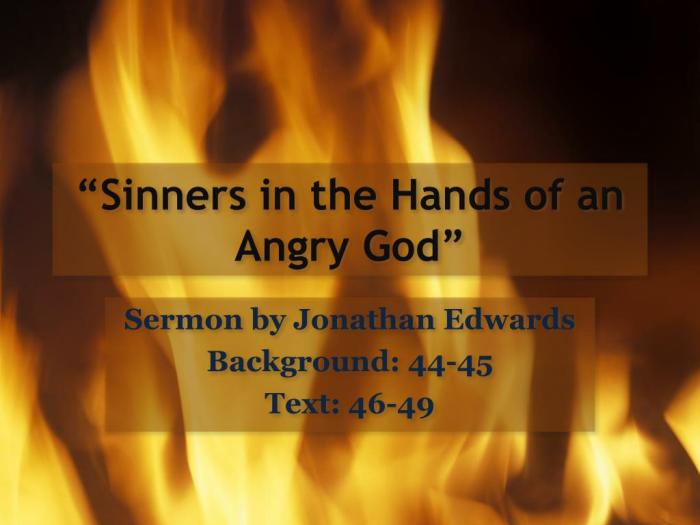Sinners in the hands of an angry god tone – Jonathan Edwards’s sermon, “Sinners in the Hands of an Angry God,” is a powerful and persuasive masterpiece of American religious rhetoric. Edwards’s use of vivid imagery, rhetorical devices, and Calvinist theology creates a sense of urgency and fear that has captivated audiences for centuries.
This sermon is a classic example of the Puritan style of preaching, which emphasized the wrath of God and the need for repentance. Edwards’s use of vivid imagery and rhetorical devices creates a sense of urgency and fear that is both captivating and terrifying.
Literary Analysis
Edwards’ sermon is a masterpiece of literary art, employing vivid imagery and symbolism to convey his message of impending doom. The sermon is structured in a logical and persuasive manner, building up to a crescendo of terror and despair.
Imagery and Symbolism, Sinners in the hands of an angry god tone
- The “bow of God’s wrath” is a powerful metaphor for the impending judgment of God.
- The “pit of hell” is a vivid image of the eternal torment that awaits sinners.
- The “wrath of the Lamb” is a paradoxical image that suggests that even Jesus Christ, who is often associated with love and mercy, will not spare the wicked.
Structure and Organization
The sermon is divided into three main parts: an introduction, a body, and a conclusion. The introduction sets the tone for the sermon, warning the congregation of the impending danger. The body of the sermon develops the argument for the sinner’s inevitable damnation, using a variety of rhetorical devices to persuade the audience.
Key Themes and Motifs
- The sovereignty of God
- The sinfulness of humanity
- The inevitability of judgment
Rhetorical Analysis

Edwards was a master of rhetoric, and his sermon is a textbook example of how to use persuasive techniques to move an audience. He employs a variety of rhetorical devices, including:
Rhetorical Devices
- Metaphor
- Simile
- Personification
- Repetition
- Alliteration
Persuasive Techniques
Edwards uses a variety of persuasive techniques to convince his audience of the truth of his message, including:
- Appeals to emotion
- Appeals to logic
- Appeals to authority
- Fear tactics
Impact on Audience
The sermon had a profound impact on its intended audience. Many people were terrified by Edwards’ vivid descriptions of hell and the wrath of God. Some people were even driven to despair and suicide. However, the sermon also had a positive impact on some people, leading them to repent of their sins and turn to God.
Historical Context: Sinners In The Hands Of An Angry God Tone

The sermon was delivered during the Great Awakening, a period of religious revival that swept through the American colonies in the 18th century. The Great Awakening was a time of great religious fervor and emotionalism, and Edwards’ sermon was one of the most famous and influential sermons of the period.
Social and Religious Climate
The social and religious climate of the time was ripe for a revival. The colonies were experiencing a period of rapid growth and change, and many people were feeling anxious and uncertain about the future. The Great Awakening offered people a sense of hope and purpose, and it helped to create a new sense of American identity.
Edwards’ Role
Edwards was one of the leading figures of the Great Awakening. He was a brilliant theologian and preacher, and his sermons were known for their power and eloquence. Edwards’ sermon “Sinners in the Hands of an Angry God” was one of the most famous and influential sermons of the period, and it helped to shape the religious landscape of America.
Theological Analysis
The sermon is based on the Calvinist theology that Edwards believed. Calvinism is a Protestant theological system that emphasizes the sovereignty of God and the sinfulness of humanity. Edwards believed that God is all-powerful and that he has predestined some people to salvation and others to damnation.
Calvinist Theology
- The sovereignty of God
- The sinfulness of humanity
- The inevitability of judgment
Edwards’ Understanding of Sin and Salvation
Edwards believed that sin is a serious offense against God and that it deserves eternal punishment. He also believed that salvation is a gift from God and that it is only available to those who have been chosen by God.
Significance in American Religious History
Edwards’ sermon is a landmark in American religious history. It helped to shape the religious landscape of America and it continues to be studied and debated today.
Cultural Impact

The sermon has had a profound impact on American literature and thought. It has been referenced in countless works of literature, including Nathaniel Hawthorne’s “The Scarlet Letter” and Herman Melville’s “Moby-Dick.” The sermon has also been used to justify everything from slavery to the Vietnam War.
Impact on American Literature and Thought
The sermon has been referenced in countless works of literature, including Nathaniel Hawthorne’s “The Scarlet Letter” and Herman Melville’s “Moby-Dick.” The sermon has also been used to justify everything from slavery to the Vietnam War.
Interpretations and Reinterpretations
The sermon has been interpreted and reinterpreted over time. Some people have seen it as a warning against sin, while others have seen it as a call for social justice. The sermon continues to be relevant to contemporary society, and it is still being debated today.
Frequently Asked Questions
What is the main theme of “Sinners in the Hands of an Angry God”?
The main theme of the sermon is the need for repentance and salvation. Edwards argues that all sinners are in danger of being cast into hell and that only through repentance and faith in Jesus Christ can they be saved.
What are some of the rhetorical devices that Edwards uses in the sermon?
Edwards uses a variety of rhetorical devices in the sermon, including vivid imagery, metaphors, similes, and hyperbole. He also uses repetition and parallel structure to create a sense of rhythm and momentum.
What is the significance of the sermon in American religious history?
The sermon is a classic example of the Puritan style of preaching, which emphasized the wrath of God and the need for repentance. It is also a powerful reminder of the importance of repentance and salvation.